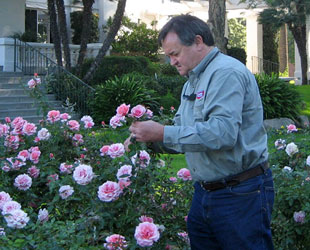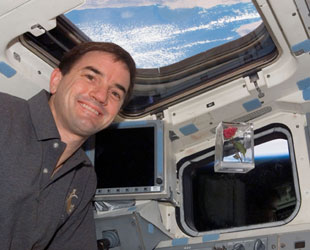December 31, 2008 — On New Year's Day in Pasadena, California, among the hundreds of thousands of roses covering nearly 50 flower-formed floats in the Tournament of Roses Parade, among the more than 12,000 roses covering the Bayer Advanced "Wizard of Oz"-themed float, will be the only rose among them all that truly flew "somewhere over the rainbow."
The two-toned pink rose, appropriately of the variety that was named after the parade ("Tournament of Roses"), circled the Earth more than 200 times in February 2008, aboard space shuttle Atlantis. How the rose came to be there, and how it is now to be a part of the parade, came as a result of the author of "Roses For Dummies" working together with an astronaut, who also happened to be his younger brother.
"I have had a long interest in roses and have written a number of books on roses," explained Lance Walheim in an interview with collectSPACE. "Everybody was always kidding me, why don't you send up a rose with Rex? The challenges of doing that, well, my staged answer was, 'Rex can't even grow a rose in his own backyard, how is he going to grow one in space?'"
The idea however appealed to Lance, and to Rex, who at the time was preparing to embark on his second mission.
"I thought that would be a great idea," shared the younger Walheim. "Since I am from California, and the Rose Parade is here in California, and he is a rose expert, it seemed like a neat idea to combine his career with my career."

Rex (right) and Lance Walheim with the space rose (NASA) |
As both brothers recalled, the problem was how to do it.
"I'm also the Bayer Advanced garden expert and we have a float in the Rose Parade every year and I thought, we could send him with a dried rose and then put it on the Bayer Advanced float. And that would be kind of fun as a promotion for the parade and also for NASA," explained Lance. "The first thing we had to do was decide how we'd dry a rose."
It turns out there were a number of ways to prepare the rose, from baking it in a kiln to putting it in a silica gel and then microwaving it. Freeze drying, which is a method NASA uses to preserve the astronauts' food, was not an option, however.
"Given the time constraints we had, I think trying to figure out a way of freeze drying it would have taken a lot of experimentation," shared Rex. "We also did not want to bother NASA with it."
Ultimately, the simplest method offered the best option. After picking several dozen of the "Tournament of Roses" roses from behind Wrigley Mansion, the headquarters of the parade, and shipping several to a kiln, Lance arrived at the answer.
"It turned out that just hanging them upside down gave us the best results," he said of the air drying process.

Lance Walheim picking roses at Wrigley Mansion (Bayer) |
The next challenge for the brothers was how to package the rose for its spaceflight. NASA provides its astronauts with a few dedicated areas to carry personal items. They can choose to pack items in the Official Flight Kit (OFK), which remains stowed for the length of the mission, or take items in their Personal Preference Kits (PPKs) and special Flight Data Files (FDFs) for access during flight.
For Rex and Lance, the choice was between protecting the flower from accidental damage and having the chance to photograph the rose while in space. Their solution was to fly two roses.
One of the dried flowers would be wrapped by NASA and stowed inside the shuttle's crew cabin, where Rex nor any of his STS-122 crewmates could get to it. The other was to fly with the FDF together with a bible and a pennant for University of California, Berkeley, Rex's and Lance's alma mater.
As the latter rose would be available to Rex during the 13 day mission to the International Space Station (ISS), he needed a way to protect it.
"Again, we're doing this all on the fly and we are thinking, 'How are we going to package this thing so it doesn't get shaken to pieces on ascent?'. We never came up with a really good idea, but what we did was we put it in a little plastic box and then handed it off to the folks at the Cape to be packed on the shuttle. We never really braced it, so we were not really sure what was going to happen to it," described Rex.
Originally, Atlantis -- with Rex and the rose aboard -- was scheduled to launch in early December 2007, which then would allow Lance enough time post-flight to get the rose into the 2008 Tournament of Roses Parade on January 1. Bayer Advanced put out a press release announcing the 'space rose' was to be on their float. The shuttle however, experienced problems with its fuel level sensors, leading to NASA delaying the mission.
Two months later, at 2:45 p.m. EST on February 7, 2008, the space shuttle lifted off from Kennedy Space Center in Florida. The bumpy ride to orbit took about eight minutes.
"When we got on orbit, I kind of sheepishly looked in the locker to see how [the rose] did and it was perfect!" Rex recalled. "It was obviously shaken pretty good on ascent but I guess it was a bit tougher than it looks. I wasn't sure when I looked in there if I was going to find rose dust or I was going to find a rose."
As planned, Rex photographed the rose floating near the window, capturing the Earth's horizon behind and below it. Otherwise, he told collectSPACE, he was happy to let it rest.

Rex Walheim with the rose aboard shuttle Atlantis (NASA) |
"I was so happy that it survived, that I was scared to do anything with it afterwards. I just wanted to hand it back to Lance and let them take care of it!" he said.
Having successfully delivered a new European laboratory to the space station, Atlantis returned to Earth, landing at just after 9:00 a.m. on February 20 in Florida.
"I went back down to NASA, and we did the handover [of the rose] back and got a tour," said Lance. "Now, I have the rose."
But not for long: on Thursday, the rose Rex photographed above Earth will be handed off to "Glinda, the Good Witch of the North" on-board Bayer Advanced's "Garden of Oz" Rose Parade float, which celebrates the 70th anniversary of the film based on L. Frank Baum's novel. In addition to the 'space rose', the float will include a yellow brick road covered in "Yellow Brick Road" yellow roses on which the Scarecrow, Tin Man, Cowardly Lion and Professor Marvel are depicted.
Rex and Lance won't be on the float themselves but will be offering commentary for the press as it passes by the parade route.
After the New Year's festivities, attention will need to turn to protecting the rose for posterity.
"Usually, a dried rose will hold up pretty well," explained Lance, but added "we'll probably have to do something to preserve the roses."
"I am not sure exactly what that is going to be, whether encasing in plastic or glass or something like that. Over the long haul, the colors will begin to fade," he continued. "But at this point, they look remarkably good."

The Bayer Advanced "Garden of Oz" float (Bayer) |
Only one of the two flown roses will appear in the parade, but both will later be displayed.
"I'm sure they'll want to have one at the Wrigley Mansion maybe for a little while. One will go back to the corporate headquarters at Bayer. In the long run, at least one of the roses will end up here with the Walheim family," shared Lance.
And what of future space roses?
"I would like to go to space again but I don't know if I will have a chance," said Rex. "I think this worked pretty well so I don't know what we would do to top it."
